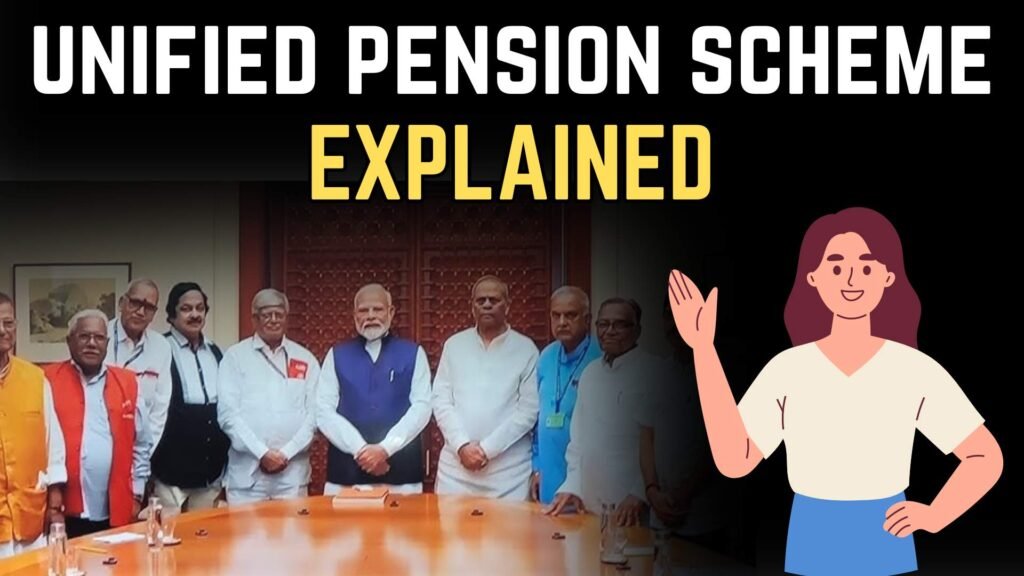Unified Pension Scheme – GD Topic with Answer
Unified Pension Scheme (UPS)
The Indian government has taken a significant step to ensure the financial security and dignity of its central government employees by introducing the Unified Pension Scheme (UPS). This scheme, approved by the Union Cabinet under the leadership of Prime Minister Narendra Modi, is set to be effective from April 1, 2025. It aims to benefit approximately 23 lakh central government employees, offering them a structured pension plan that promises stability post-retirement.

What is the Unified Pension Scheme (UPS)?
The Unified Pension Scheme (UPS) is a newly launched pension plan by the Central Government of India, designed to provide a steady pension to government employees based on their length of service and the most recent basic salary drawn. This scheme is a significant development in the realm of government employee benefits, offering a more predictable and secure financial future for those who dedicate their careers to public service.
Under UPS, central government employees have the option to choose between the existing National Pension Scheme (NPS) and the new Unified Pension Scheme. Additionally, those who are already enrolled in NPS will have the opportunity to switch to UPS. State governments are also expected to adopt the Unified Pension Scheme in the near future.
Key Features of the Unified Pension Scheme (UPS)
- Minimum Pension Guarantee: UPS offers a minimum pension of ₹10,000 per month to employees who have completed at least 10 years of service. This minimum pension ensures that even those with shorter service periods receive a respectable pension.
- Family Pension: In the unfortunate event of an employee’s death, the scheme provides an assured family pension. The family pension is set at 60% of the deceased employee’s pension, ensuring that the family is financially supported.
- Lump Sum Payment: Upon retirement, employees will receive a one-time payment equivalent to 10% of their salary and dearness allowance (DA) for every six months of service. For those with 30 years of service, this could translate to a substantial amount, separate from the gratuity.
- Actuarial Review: To prevent the scheme from becoming a financial burden on the government, an actuarial calculation will be conducted every three years. This review ensures that the liabilities are adequately funded, avoiding the pitfalls of the Old Pension Scheme (OPS).
- Inflation Indexation: The pension, family pension, and minimum pension under UPS will be inflation-indexed, with Dearness Relief based on the All India Consumer Price Index for Industrial Workers (AICPI-IW). This ensures that the pension maintains its value over time, keeping pace with inflation.
Eligibility for the Unified Pension Scheme (UPS)
The UPS will be applicable to all Central government employees retiring on or before March 31, 2025. Employees who are currently under the NPS will have the option to switch to UPS, making it a flexible choice for government employees.
The Five Pillars of UPS
The UPS is built on five core principles:
- Assured Minimum Pension: A minimum pension guarantee of ₹10,000 per month.
- Family Pension: Financial security for the employee’s family with a pension set at 60% of the employee’s pension.
- Lump Sum Retirement Benefit: A significant one-time payment upon retirement.
- Actuarial Review: Regular financial assessments to ensure sustainability.
- Inflation Protection: Pensions indexed to inflation to preserve purchasing power.
Difference Between UPS, NPS, and OPS
The table below highlights the key differences between the Unified Pension Scheme (UPS), National Pension Scheme (NPS), and the Old Pension Scheme (OPS):
| Feature | Unified Pension Scheme (UPS) | National Pension Scheme (NPS) | Old Pension Scheme (OPS) |
|---|---|---|---|
| Implementation Date | April 1, 2025 | Introduced in 2004 | Prior to 2004 |
| Eligibility | Central govt. employees retiring by 2025 | Govt. employees joining after 2004 | Govt. employees before 2004 |
| Pension Amount | Based on last drawn salary and service | Market-linked, depends on contributions | 50% of last drawn salary |
| Minimum Pension | ₹10,000/month after 10 years of service | No guaranteed minimum | No minimum, but higher pension possible |
| Family Pension | 60% of the employee’s pension | Depends on accumulated corpus | 30%-50% of last drawn salary |
| Lump Sum Payment | 10% of salary & DA per 6 months of service | No lump sum on retirement | No lump sum |
| Contribution by Employee | No contribution required | 10% of salary + DA | No contribution required |
| Actuarial Review | Every 3 years | No actuarial review | No actuarial review |
| Inflation Indexation | Yes (Dearness Relief based on AICPI-IW) | No | Yes (Dearness Allowance) |
Conclusion
The Unified Pension Scheme represents a significant shift in how the Indian government approaches the retirement security of its employees. By combining elements of both the old and new pension systems, the UPS aims to provide a more secure and predictable future for government employees while maintaining financial sustainability. With its assured benefits and inflation protection, the UPS is set to become a cornerstone of retirement planning for central government employees.
Must Explore







